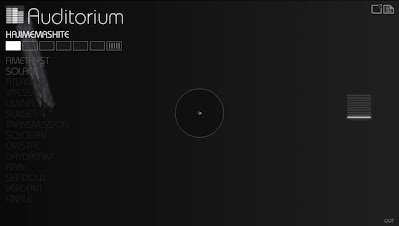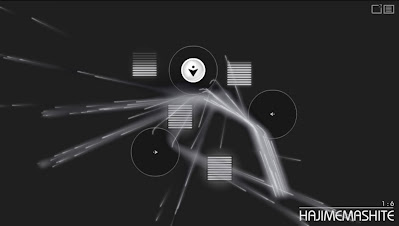Redefining "Streaming Music"
From one musical puzzler to another, this time Auditorium, which gives you no choice on which music to listen to, and one heck of a particle puzzle to piece together before you're allowed to listen to the oh so chill tracks it offers.
Sit back, relax, and get ready to fiddle with some particle streams in an attempt to bring the orchestra to life.
Fun Times
You'll have next to no idea what you're heading into when you load up Auditorium. A minimalistic intro makes way for a menu full of greyed out levels with unusual names, and an absolutely nonsensical one to begin your musical journey on: Hajimemashite. Indeed.
A stream of particles shoots out of the black void that forms a level. You're given a gravitational tool to bend this stream in the direction the tool works, in this case, up, and can freely position and scale its influence on the particle stream in an attempt to fill up a bucket.
When you find just the right spot to position the tool, the particles shoot into the bucket and the music begins to swell up. The more particles that land in the bucket, the louder and more energetic the music, and once the bucket is full, the level fades away and you're left to listen to the full track until you decide to click to the next challenge.
Levels will have you using more tools and filling more buckets, but this is the core of Auditorium. Use the things to fill the buckets. Simple, elegant, wonderful to look at, but, at times, awfully thinky.
This isn't a puzzle game so much as it is an executive toy, something to show how sophisticated you are. It's playtime, not work, as you tinker with the placement of one of your tools, increasing its size to bend the particle stream a little more, repositioning another tool accordingly, before eventually, all the buckets start to fill up - by accident or design - and the music reaches its height.
The introduction of colour changing may initially fill you with a little dread. The puzzles surely get much harder now that I have to factor colour changing in, but if anything, trying to find a solution allows you to stretch out the music to spend more time with it.
Each daunting level design can be seen as a blank canvas of sorts. You're not making the music directly, but are influencing when you hear it. Each movement of the tools you're given is a step towards discovering something else about how Auditorium works.
You tease the music out of the darkness. Each time you think you have a solution, you'll see one bucket drop out of the picture, the stream no longer filling it. You're so close, but this needs moving just a tad, and now that does, and now this is broken, and the music fades away and you're sad, but then you luck into something special, particles fly everywhere, buckets fill up and the level fades away in success, the music now complete, your artwork hanging in the blackness.
One click and the next level is ready, waiting for you to bring another piece of music to life. No, I can't describe the genre. Lots of pianos and strings. It's lovely, as are the new tools that get introduced one by one. This swirly thing causes chaos, but the chaos that can be controlled and harnessed and bent into the right shape.
Obstacles will split the stream in two. They're fixed and you don't even have to make use of them if you've fallen upon a solution that otherwise works. Don't worry about whether you completed a level in record time or with maximum efficiency. Just go out and enjoy creating something, some audibly and visually.
As the fourth Act ended and flowed straight into the fifth, I was given the bunny. This tool speeds up the particle stream, allowing it to zip from one side of the screen to another. How could it be used? What does it mean to give a stream a burst of speed? When is the best time to use it? Where do you position it?
While there had been a few times where I thought that, before moving some tools and stumbling into something that might just work, with this level I must have hit the wall. On another day I might have breezed through it. Heck, maybe if I cocked my head to one side I'd have a revelation or something, but cock my head I did not.
Final Word
I put Auditorium back on the digital shelf, making a note to come back to it some time. It's not a sprawling game with hour after hour of content, but what it offers is so straight to the point and delightful to experience that too much content would perhaps spoil it.
What makes it special is the presentation. You could do a gravity-based physics puzzler in many ways, but to do it like this is to capture the attention of players who wouldn't gravitate towards an obvious gravity-based puzzler if you'll pardon the pun, which you bloody well will.
Auditorium is chill. It might be annoying when you struggle to find a solution, but the music coming into and out of existence based on your actions is something you really do have to see and do first hand. Think of it as a toy and you won't notice the time fly by.
Fun Times
A co-op sequel was successfully Kickstarted just shy of 10 years after the Flash original but was ultimately cancelled.
Auditorium, developed by Cipher Prime, first released in 2008.
Version played: PC, 2012.
































